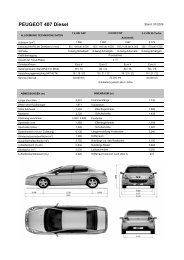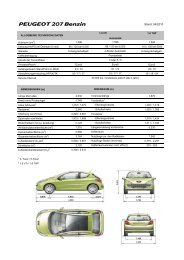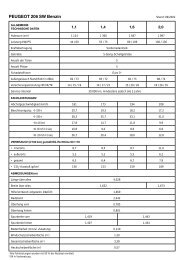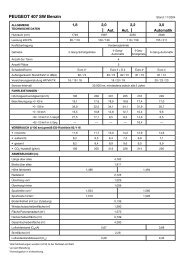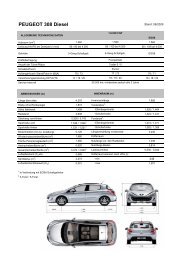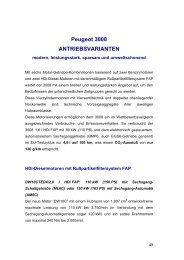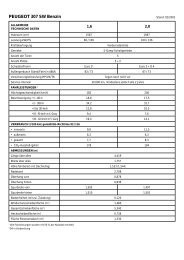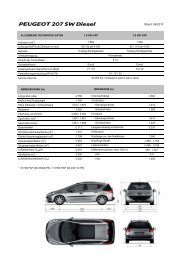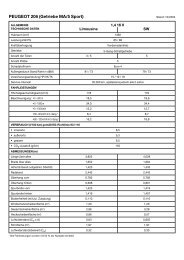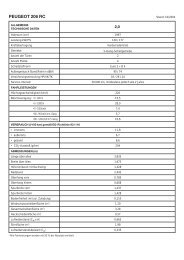PSA COUV page . page RA GB - PEUGEOT Presse
PSA COUV page . page RA GB - PEUGEOT Presse
PSA COUV page . page RA GB - PEUGEOT Presse
Create successful ePaper yourself
Turn your PDF publications into a flip-book with our unique Google optimized e-Paper software.
➔ Note 1 - Accounting policies<br />
The consolidated financial statements are presented in accordance with<br />
French generally accepted accounting principles.<br />
The impact on the consolidated financial statements of adopting<br />
standard CRC 2000-06 concerning liabilities, effective from 2002, was<br />
not material.<br />
Group accounting policies, described in notes 1(a) to 1(s) below, are<br />
consistent, in all material respects, with accounting principles generally<br />
accepted in the United States of America (US GAAP) except as<br />
explained in note 2.<br />
a) Consolidation<br />
The financial statements of significant subsidiaries in which Peugeot S.A.<br />
holds directly or indirectly a majority interest are fully consolidated.<br />
Companies in which Peugeot S.A. holds directly or indirectly an<br />
interest of 20% to 50% and exercises significant influence over<br />
operating and financial policies are included in the consolidated<br />
financial statements on an equity basis.<br />
Certain companies meeting the above criteria have not been<br />
consolidated as they are considered not material in relation to the<br />
Group as a whole. Investments in these companies are recorded under<br />
“Shares in non-consolidated companies” (note 19).<br />
All significant intercompany transactions are eliminated.<br />
Newly-acquired subsidiaries are consolidated as from the date of<br />
acquisition.<br />
b) Translation of foreign currencies<br />
Foreign currency amounts are translated as follows:<br />
- transactions in foreign currency are translated at the hedging rate,<br />
except for the limited number of transactions that are not hedged;<br />
- at the balance sheet date, monetary assets and liabilities denominated<br />
in foreign currency which are not hedged are translated at the yearend<br />
exchange rate;<br />
- gains and losses resulting from the translation of foreign currency<br />
transactions are included in earnings, with the exception of those<br />
related to transactions representing an investment of a permanent<br />
nature in a subsidiary, which are included in stockholders’ equity<br />
under “Retained earnings”;<br />
- balance sheets of foreign subsidiaries are translated at the year-end<br />
exchange rate;<br />
- income statements of foreign subsidiaries are translated on a monthly<br />
basis at the average rates of each month;<br />
- gains and losses resulting from the translation of financial statements<br />
of foreign subsidiaries are recorded in stockholders’ equity under<br />
“Cumulative translation adjustment”.<br />
c) Use of estimates<br />
The preparation of financial statements and related disclosures in<br />
accordance with generally accepted accounting principles requires<br />
management to make estimates and assumptions that affect amounts<br />
reported therein.<br />
d) Sales and revenues<br />
1. Manufacturing and sales companies<br />
Sales of the manufacturing and sales companies include revenues from<br />
the sale of vehicles and other goods and services.<br />
Vehicle sales<br />
New vehicle sales are recognized on the date of transfer of the risks and<br />
rewards of ownership. This corresponds generally to the date when the<br />
vehicles are made available to non-group dealers or the delivery date,<br />
in the case of direct sales. The amount recognized is stated net of the<br />
cost of certain sales incentive programs.<br />
New vehicle sales with a buyback commitment expiring within a<br />
maximum of three years are not recognized at the time of delivery but<br />
accounted for as operating leases. The difference between the sale price<br />
and the buyback price is recognized over the leasing period. The profit<br />
corresponding to the difference between the resale value of the vehicle<br />
on the used car market and the cost of the new vehicle is recognized in<br />
the period when the vehicle is sold. If the difference is a loss, an<br />
allowance is booked when the buyback contract is signed.<br />
2. Finance companies<br />
Finance company revenues correspond to interest income, mainly from<br />
sales financing, and financing-related service revenues.<br />
Sales financing revenue<br />
The activity of finance companies is to provide wholesale financing to<br />
Group dealer networks and to finance sales of vehicles to customers.<br />
Financing may take the form of conventional loans, finance leases,<br />
buyback contracts or long-term leasing and is treated in the same way<br />
as loans. Outstanding principal is recorded in the balance sheet,<br />
together with interest due up to the loan repayment date (note 23-b).<br />
Income from the financing of sales is recognized on an actuarial basis<br />
at a constant rate of interest over the life of the loan.<br />
Revenues from retained interests in asset-backed securities issued by<br />
funds set up in connection with the securitization of automobile loans<br />
are included in sales financing revenue.<br />
Commissions and other fees paid to referral agents are included in cost<br />
of sales over the loan period.<br />
Other business acquisition and loan administration costs are expensed<br />
when incurred.<br />
e) Sales incentive programs<br />
The cost of sales incentive programs is charged against earnings for the<br />
period in which the corresponding sales are recognized. It is accrued on<br />
the basis of historical costs for the previous three months, determined<br />
country by country.<br />
Effective from 2001, in cases where the cost of the program varies<br />
based on sales volume, it is deducted from sales (note 4-a)2).<br />
Incentive programs established by the Group include the granting of<br />
retail financing at rates significantly below market rates. The<br />
corresponding cost is recognized at the time of the sale.<br />
f) Product warranty costs<br />
A reserve is recorded to cover the estimated cost of vehicle warranties<br />
at the time of sale to dealer networks or to the end customer. Revenues<br />
from the sale of extended warranties and maintenance contracts are<br />
recognized over the period during which the service is to be provided.<br />
g) Research and development costs<br />
All research and development costs, including research into production<br />
methods, are expensed as incurred. Automotive Equipment development<br />
<strong>PSA</strong> <strong>PEUGEOT</strong> CITROËN - APPENDICES TO THE MANAGING BOARD REPORT 139




